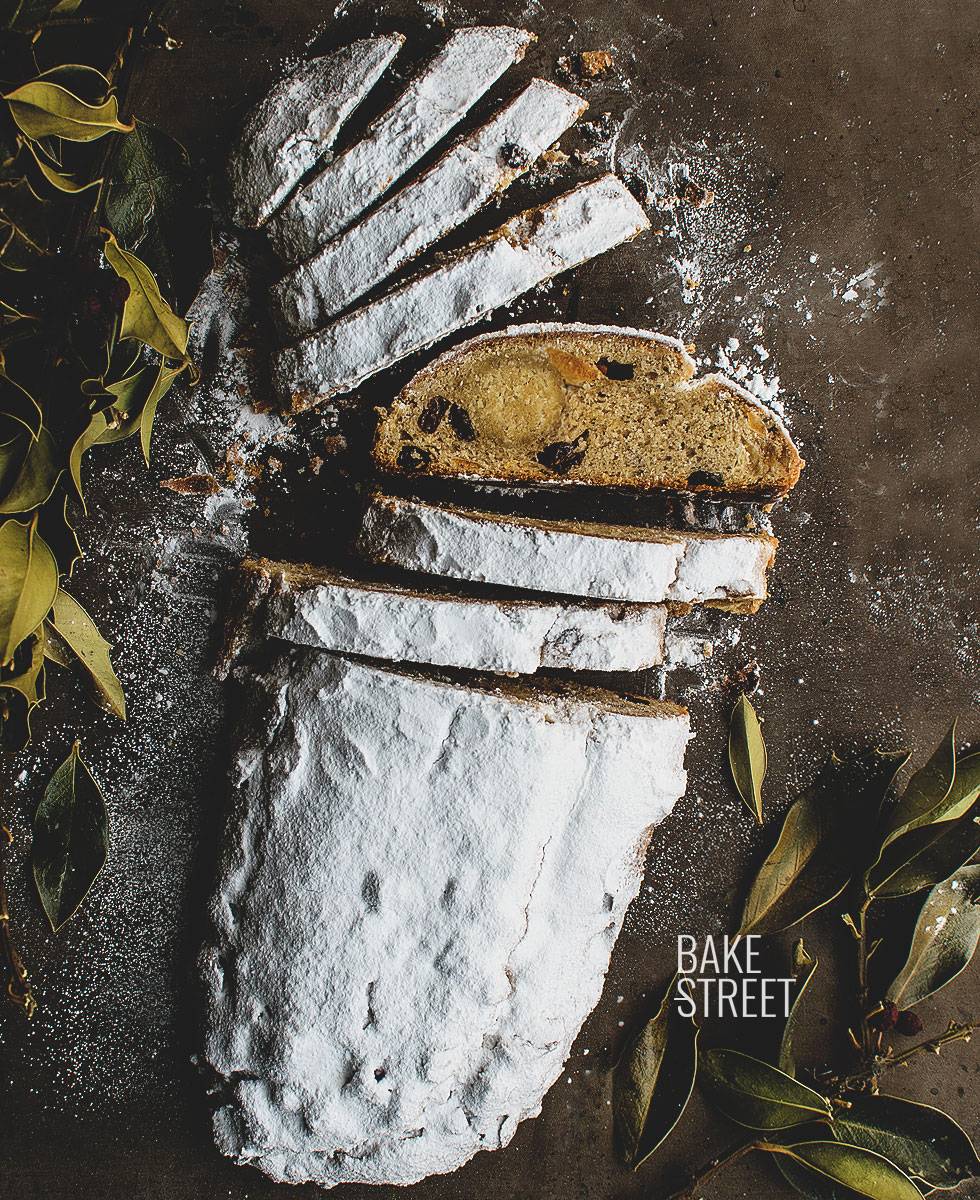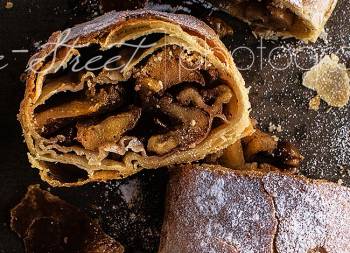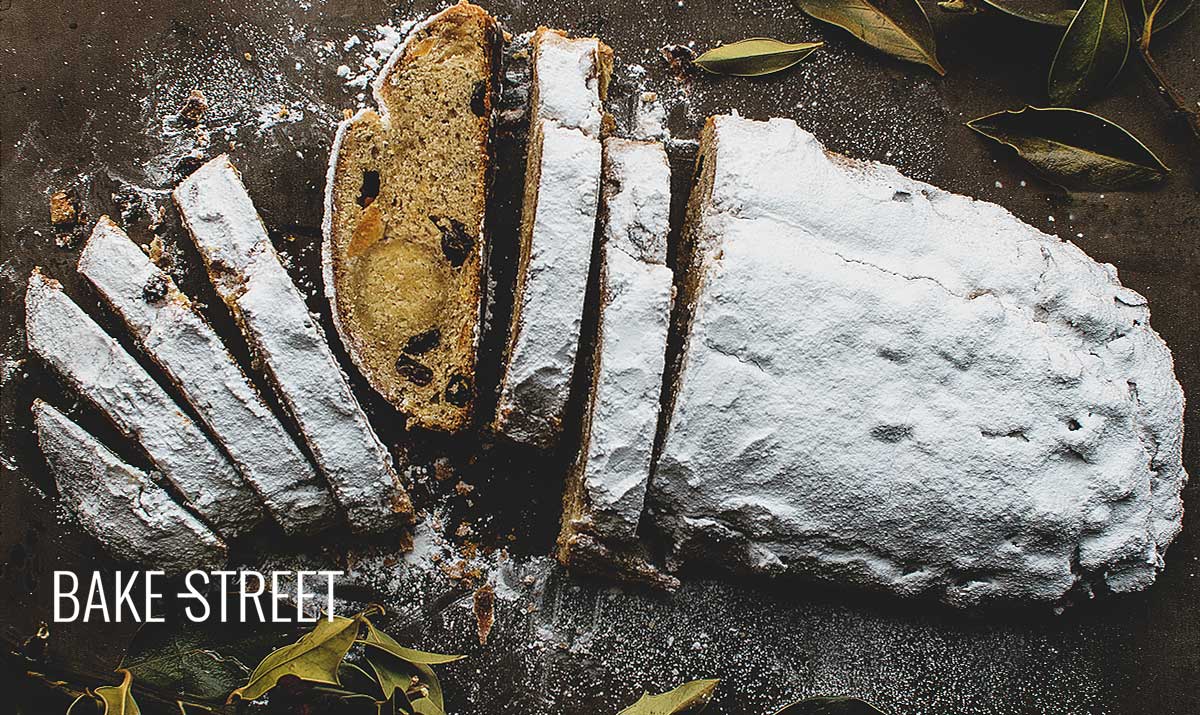
Stollen, German Christmas bread
How many times have you written to me asking me about the Stollen recipe… Ok, voilà! you already got it. The truth is that I am not surprised that this recipe has been so requested in recent months, because it is one of those delicacies that make our eyes turn around while we enjoy after each bite. We must recognize that the stollen is not attractive, in spite of how good it is.
This bread of German origin also known as Weihnachtsstollen or Christstollen is usually served as a dessert at Christmas or Advent and its appearance is compared to a newborn baby wrapped in diapers. Hence the use of icing sugar to cover all its exterior.
Stollen is a sweet bread made with a significant amount of butter, slightly more than 50% of the weight of flour, very little sugar inside and a large amount on the outside, as well as a very generous addition of candied fruits. As I said above, a delicacy for the most exquisite palates.
The origin of the Stollen.
It is a bread with a long tradition in German cuisine. The first written mention of Stollen dates back to 1329 in Naumburg (Saale), being offered as a Christmas gift for a bishop. With the passage of time, it has maintained its shape with very few changes. They want to maintain the intention of imitating a baby wrapped in diapers, making reference to the newborn baby Jesus Christ.
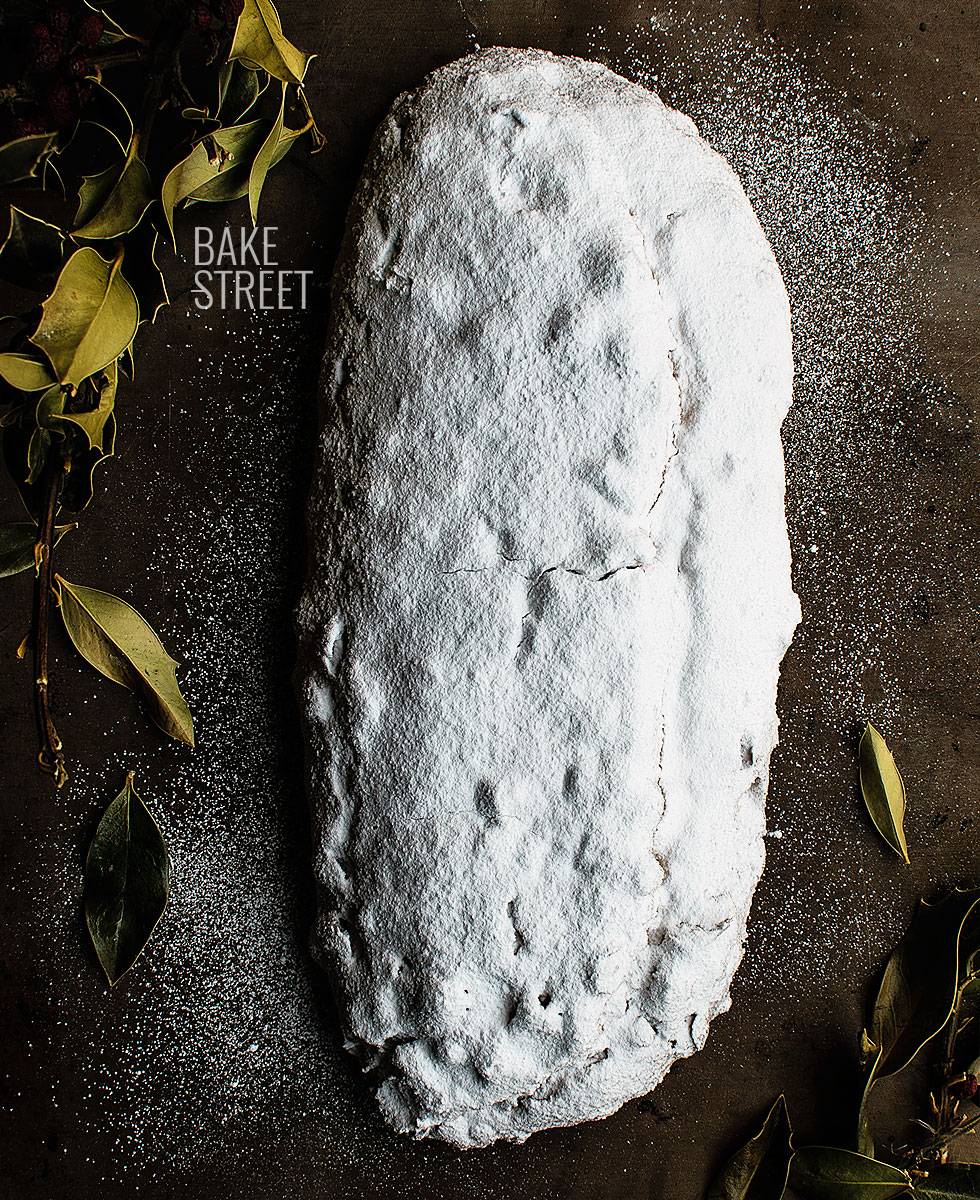
During Advent, a word derived from adventus and meaning “coming”, Christians prepared for the celebration of the Nativity of Jesus. During this time they lived in a time of fasting when they were not allowed to drink milk or butter.
For that reason, the bakers had to make this Stollen with oats, water and oil, giving rise to a hard and tasteless bread. The results of this elaboration were not pleasing to the nobles of the time, so they begged PrinceErnst von Sachsen in 1430 to intercede with Pope Nicholas V to include butter in its elaboration. This request was rejected.
The introduction of butter for the Stollen.
The first Pope who allowed to introduce butter into this bread during the fasting season in Advent was Innocent VIII in 1491. To do this he wrote a letter which they called “Letter of butter” – “Butterbrief” (remember that I commented on this post), in which it was specified that the oil of turnips could be replaced by butter.
These permits were available to the entire population but had certain conditions:
- Each person using this permit would have to pay a church tax, a fixed amount per year for a period of 20 years. A quarter of the proceeds would go to help pay for St. Peter’s Basilica in Rome
- Then another permit was issued, under the same conditions as the previous one. A fixed amount per year for a period of 20 years, to help rebuild Freiberg Cathedral after a fire in 1484.
The permits were intended for all processing operations requiring the use of butter.
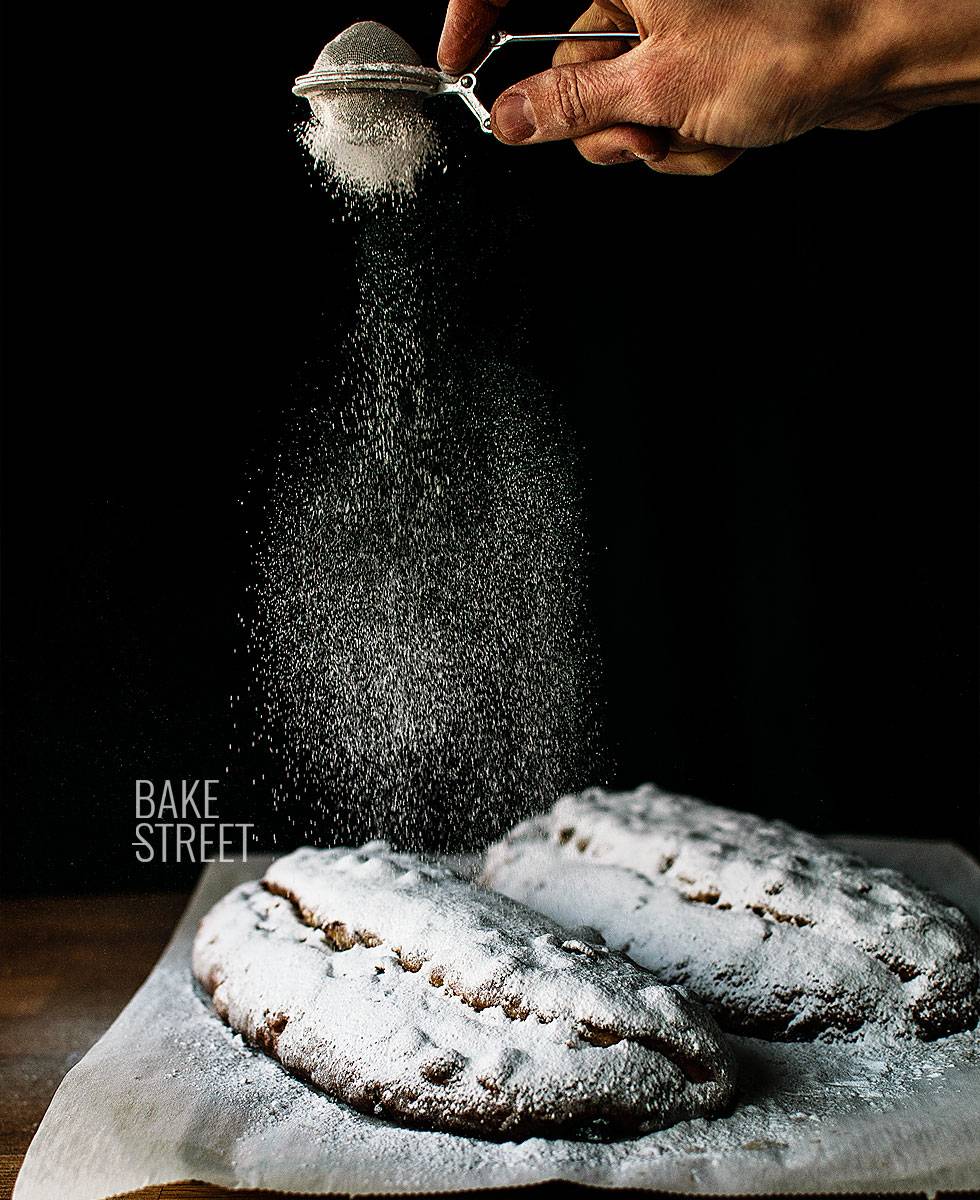
The dried fruits for the Stollen.
Tradition says that a royal pastry chef named Heinrich Drasdo de Torgau (Sachsen) was the first to add dried fruits to this bread who thought it was too dull to be a Christmas bread. From here it evolved as we know it today. A genuine Dresden stollen must contain at least 65% candied frutis in relation to the weight of the flour.
After almost 150 years after its first production in Naumburg, the Christstollen is once again mentioned in Dresden. In an invoice for the court, the date Anno 1474 appears together with the concept Christbrod, in this region was called the Stollen “Striezel“.
This is how the origin of the Christmas market called “Striezelmarkt” gets its name from the sale of these breads. As a curious note on its elaboration, it is said that after being baked they must rest 3 weeks in a fresh place so that the fruits are flavored bread and ripe flavors.
Dresden and its denomination of origin.
At the end of the Thirty Years’ War in 1648, the Dresden confectioners claimed their privileges as the only Stollen salesman on the Striezelmarkt.
The denomination of the Dresdner Stollen was freely given by any baker in Germany, but during its unification the origin of the product was discussed. Since 1997, its name has been protected so that only those made in Dresden can be called this way.
In this way, the recipes of more than 150 pastry chefs are protected, guaranteeing the consumer their denomination of origin. Their popularity spread throughout Germany, so we can enjoy them everywhere.
The varieties we can find are these:
- Mandelstollen or Almond Stollen
- Butterstollen or Butter Stollen
- Marzipan/Persipanstollen made from a marzipan or persipan mixture (mixture of marzipan and peach)
- Mohnstollen or Stollen of poppy seeds
- Nuss-Stollen or Walnut Stollen
- And the famous Dresdner Stollen, with its own trademark.
The recipe.
The recipe for this Stollen, I have followed the book “Advanced Bread and Pastry“. I’ve just modified a few things. I’ve reduced the final amount of butter. In the elaboration of the book they use 330 g instead of the 250 g that I leave you. I also reduced the quantity of yeast because it was too high… But it wasn’t such a bad idea, considering the amount of proof time I had to do.
They recommend using 5.34% yeast in relation to the amount of flour. That is equivalent to 23 g of osmotolerant dry yeast, with the amount of flour I have used. I thought it was an absolute barbarity, but as I told you, it wasn’t such a bad idea.
We must also take into account the addition of fruits, these will not allow to rise the dough very easily because it increases its weight a lot. In fact you will not notice that the dough does not double in either of the two proofs.
Normally I introduce the fruits after the first fermentation, so that the dough is lighter and we can better observe how much has grown. But this time I decided to do it as specified in the book and as I have seen in some German recipes. You can always follow this second option.
The end result.
The taste can’t be explained in words… It’s incredibly spectacular. Aromatic, sweet and delicate. The crumb is very soft and tender, despite its compact appearance. Do not be fooled by this point. It is an elaboration worth carrying out.
Ingredients for 2 breads
FOR THE DOUGH:
- 15 oz (425 g) bread flour
- 5,3 oz (150 g) whole milk
- 8,8 oz (250 g) unsalted butter at room temperaturee
- 1,95 oz (55 g) egg (1 large egg)
- 2,3 oz (65 g) sugar
- 0,18 oz (5 g) spices (cinnamon, cardamom, nutmeg, clove y all spice. See notes)
- 0,28 oz (8 g) osmotolerant dry yeast
- 0,3 oz (9 g) salt
- 4,75 oz (135 g) marzipan for one bread (recipe below)
FOR THE MARZIPAN FOR 2 BREADS:
- 8,8 oz (250 g) ground almond
- 7 oz (200 g) sugar
- 1,75 oz (50 g) icing sugar
- 1 large egg white
- 4,23 oz (120 g) water
- ½ tsp vanilla extract
CANDIED FRUITS:
- 3,17 oz (90 g) candied orange (link recipe, make them in the same way that lemons)
- 3,17 oz (90 g) candied lemon (link recipe)
- 5,3 oz (150 g) raisins
- 3,5 oz (100 g) dried apricots
- 2,3 oz (65 g) rum
FOR BRUSH:
- 4,4 oz (125 g) melted butter
- sugar
- icing sugar
Instructions
The night before.
- In a bowl add the raisins together with the chopped apricots, pour the rum and mix.
- Cover with film and leave to macerate overnight.
FIRST DAY
Make the dought.
- Keep 2 tablespoons of milk.
- In a bowl add the flour together with the spices, egg, milk, salt and sugar. Mix with your hands to amalgamate the ingredients.
- Start to integrate the butter into the mixture and work to start mixing it. We'll get a sticky dough that's hard to handle.
- Dissolve the yeast in the milk and add it to the dough. Knead again until it is fully integrated.
- Once we have added all the butter, knead until you get a good gluten development. The dough must be elastic and not cracked. It will take us a long time to reach this point, we must make an intensive kneading. About 60-70 minutes.
Add candied fruits.
- Roll out the dough slightly and dump the candied orange and lemon, the raisins and chopped dried apricots, previously drained.
- Fold the dough in the same way that we would shape a boule and start kneading gently to help the fruit to be distributed evenly. This step will not be easy... The dough becomes difficult and difficult to handle.
- Once we have the fruits integrated, make a ball with the dough.
- Grease a tupper or hermetic container, introduce the dough inside and let it rise until almost grows 1/3 of its volume. Depending on the temperature it can take 6-8 hours. In my case it was 8 hours at 77ºF.
- Store in the refrigerator until the next day.
Make marzipan.
- In a bowl mix the ground almonds together with the icing sugar, egg white and vanilla.
- In a saucepan pour the water together with the sugar and place over medium-high heat. Let it boil over without stirring.
- It must reach 110 degrees, we'll help with a kitchen thermometer.
- Remove from the heat and pour over the almond mixture in a thin, continuous thread and mix it with a silicone spatula.
- We must mix the batter until all the ingredients are homogenized and make it compact, so that we can work knead with our hands.
- shape a cylinder, cover with film and put in the refrigerator for at least 1 hour or until the next day.
SECOND DAY
Shape the Stollen.
- Warm the dough 2 hours before working with it.
- Dump the dough on a clean surface and divide it into two equal pieces, about 23 oz.
- Pre-shape and let stand for 20 minutes covered with a plastic film.
- Using a roller we stretch the dough to shape a rectangle.
- At one end, we create a gap by pressing with the roller.
- Place the marzipan and fold the dough over it.
- Finish shaping by pressing the top with the roller.
- Place on a tray lined with baking paper, leaving space between the two since they will grow during baking.
- Cover with film and let rise until it grows 50% of its volume, does not double. In my case it was 3 hours at 77ºC.
Bake the Stollen.
- Preheat oven to 375ºF.
- Bake for 35 minutes. Remember that the temperature inside must reach 190-195ºF for cooking to be complete.
- Remove from the oven and remove dried fruits from the surface. They will taste bad and will be very dry.
- Brush with melted butter and let cool completely on a rack.
- Once it has cooled, brush again with melted butter, batter in sugar and sprinkle very generously with icing sugar.
How to preserve it in time until Christmas?
- Once the stollen has been sprinkled with icing sugar, wrap it in paper.
- Then keep it in a zip bag and store it in a wood or metal can, in case we have one. Otherwise we can preserve it only with paper and inside the bag.
- It should be kept in a cool, dry place. Ideally, it should be stored for about 4 weeks.

Notes
- The dried fruits can be macerated in rum or other liquor, if you prefer. On one occasion I made it in almond liqueur and they were spectacular.
- The dough has most of its hydration through the butter, this means that we must add it from the beginning. Its kneading is very laborious, do not hesitate or stop kneading in kneader/ dough mixer if you can. In my case, half the kneading was done this way.
- The amount of spices must be in equal proportion for all of them, this means that we will use 1 g of each one.
- Must the yeast be obligatorily osmotolerant? what is that kind of yeast? Yes, we must use that variety of yeast that is specific to enriched doughs. This yeast can best support proof in doughs with very high amounts of fat and sugar.
- Can I use dry baker's yeast? Yes, but their ability to make the dough rise may be greatly reduced.
- The amount of marzipan I leave you is for two stollen, you'll have a little left over.
- If we decide to elaborate the stollen without marzipan, we will follow the same shaping process omitting only marzipan.
- It is very important that you make the syrup well to get a perfect marzipan, otherwise the result will be a soft marzipan, liquid and unmanageable.
- If you can, let the stollen stollen rest for a few weeks before consuming it. In fact, if you make it now, you'll have it perfect to consume at Christmas time ;)

Now you really don't have an excuse to try this exquisite Stollen. If we look on the bright side, even though I don't see any bad ones (removing the 300,000 hours of kneading), we can go around preparing our Christmas sweets and arriving the dates, enjoying it.
At home they will thank you immensely, and I am sure that their majesties from the East or Santa Claus will make up for this. I hope you have a great weekend! I'll see you Monday.
Big hugs,
Eva
Source: Wikipedia
